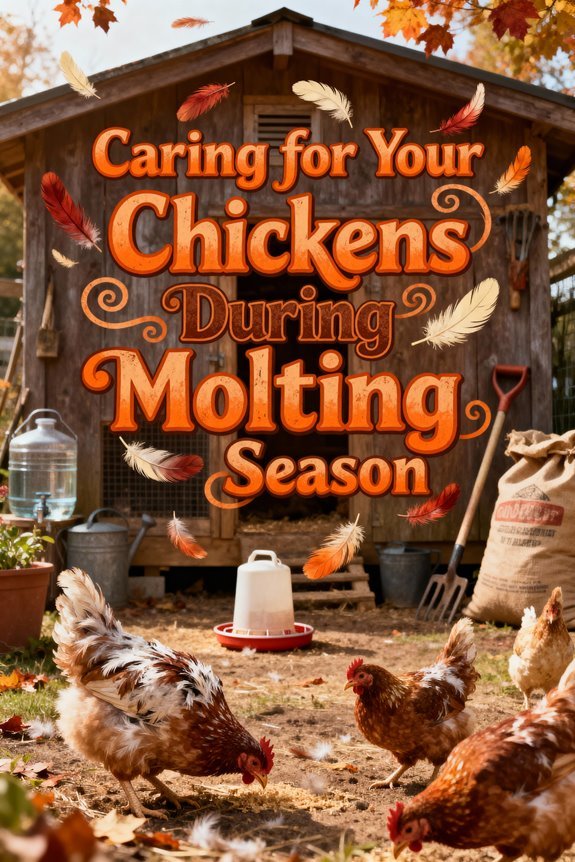Which Chicken Breeds Lay Beautiful Blue Eggs?
You’ll find six exceptional chicken breeds that lay stunning blue eggs: Ameraucana, Araucana, Cream Legbar, Easter Egger, Arkansas Blue, and Whiting True Blue. The oocyan gene produces biliverdin pigment in their shell glands, creating eggs in varying blue hues. Ameraucanas offer reliable production with 150-200 eggs annually, while Cream Legbars can yield up to 280 eggs per year. Each breed brings unique characteristics and production levels to your flock.
Understanding the Magic Behind Blue Eggshells
While most people think of eggs as simply white or brown, the remarkable blue hues found in certain chicken breeds result from a complex biochemical process involving biliverdin, a green tetrapyrrolic bile pigment. As your chicken’s egg develops, blue pigment synthesis occurs in the shell gland, where heme oxygenase enzymes catalyze the conversion of heme into biliverdin. This process happens about 3-4 hours before the egg is laid. Ameraucana chickens are particularly prized for their consistent blue egg production throughout their laying cycles. The intensity of the blue color you’ll see depends on the concentration of biliverdin deposited throughout the eggshell layers. Genetic factors, particularly the dominant Oocyan gene, control this trait. The shell gland’s activity and genes like HMOX1 and ABCG2 work together to regulate pigment production and transport, determining whether your chicken will lay those coveted blue eggs. The regular Sapphire chickens are among the select breeds capable of producing these stunning blue eggs. If you see an olive or khaki color instead of pure blue, this indicates the presence of protoporphyrin-IX coating on the shell.
The Beloved Ameraucana: America’s Blue Egg Champion
The Ameraucana stands as America’s premier blue-egg laying breed, developed in the 1970s through careful genetic selection from Chilean Araucana stock. These birds feature distinctive facial muffs and a full tail, traits that differentiate them from their Araucana ancestors. You’ll recognize them by their pea comb, slate-blue legs, and red earlobes. Their pastel blue eggs are consistently beautiful and highly sought-after by backyard chicken keepers.
Unlike Easter Eggers, Ameraucanas consistently produce medium-sized blue eggs, laying approximately three per week. These dedicated layers produce 150 to 200 eggs annually, with slight decreases during molting periods. You’ll find them in eight recognized color variants, including black, blue, and wheaten. While they’re excellent foragers with an intelligent, docile nature, they don’t excel at brooding.
Their hardiness makes them adaptable to various climates, with their short pea comb and facial feathering offering protection against cold without compromising their heat tolerance. They thrive best when given ample space to explore. Their hawk-like appearance provides natural protection from predators in the backyard.
Araucana: the Original Blue Egg Layer From Chile
Indigenous Mapuche peoples of Chile’s Araucanía region developed these extraordinary blue-egg-laying chickens long before Spanish explorers arrived in South America. The Araucana history gained international recognition after Salvador Castelló’s 1914 observations and the 1921 World’s Poultry Congress.
You’ll find that Araucana genetics are particularly fascinating. Their distinctive blue eggs result from a dominant oocyan gene, which produces a unique pigment in the eggshell. These chickens also exhibit characteristic tufted ears and rumplessness. When crossed with other breeds, their dominant blue-egg gene can create olive or green-shelled eggs in offspring. Hens typically produce 150 to 200 eggs annually.
Originally known as Gallina Mapuche, these hardy birds have spread globally since their 1930s introduction to the United States. Many farmers enhance their flock’s health with oregano oil supplements to maintain strong immune systems naturally. Unlike their Crested Cream Legbar cousins who lay medium to large eggs, Araucanas lay slightly smaller eggs. They’ve contributed considerably to other blue-egg-laying breeds, including Ameraucanas and Easter Eggers.
Cream Legbar: The Crested Blue Egg Beauty
British poultry breeders created Cream Legbars in the 1930s through selective crossbreeding of Gold Legbars, White Leghorns, Silver Cambars, and Cream Araucanas. This innovative breeding technique produced an auto-sexing breed, allowing you to identify chick gender at hatching through distinct plumage patterns. Their docile, friendly nature makes them excellent pets for families with children.
You’ll recognize Cream Legbars by their distinctive head crests and silver-grey barred bodies. Hens lay 200-280 striking blue to pastel green eggs annually, weighing 60-80 grams each. Unlike Ameraucanas that produce pure blue eggs, Cream Legbars offer more variation in their egg colors. Starting at 5 to 6 months of age, these hens begin their productive laying journey. They’re exceptional foragers, requiring ample outdoor space to thrive. Their care requirements include sufficient room to roam and protection from extreme weather, though they adapt well to various climates. While they’re not typically broody, these friendly birds maintain consistent egg production and integrate well into backyard flocks, making them ideal for both urban and rural settings.
Easter Egger: A Rainbow of Possibilities
While many chicken breeds produce standard brown or white eggs, Easter Eggers stand out as genetic marvels that lay eggs in stunning shades of blue, green, olive, and occasionally pink. These unique birds derive their egg-laying capabilities from Araucana genetics, with each hen consistently producing her signature color throughout her laying career. These docile birds are rarely broody hens, making them excellent producers without the disruption of maternal instincts.
Easter Eggers’ characteristics include medium builds weighing 4-6 pounds, distinctive poofy cheeks, and beards. You’ll find their feathering varies dramatically, showcasing patterns from solid to spotted. Unlike heritage strain Rhode Island Reds, Easter Eggers begin laying earlier and more consistently. To keep these birds healthy, owners should avoid feeding them toxic nightshade plants like tomato leaves and potato stems. Easter Eggers’ genetics contribute to exceptional hybrid vigor, resulting in robust health and impressive laying capabilities of 200-280 eggs annually. They’re ideal for backyard flocks, combining friendly temperaments with reliable production. Unlike pure breeds, they’ll maintain steady laying even during temperature extremes, making them a practical choice for year-round egg production.
Arkansas Blue: The Productive Hybrid Choice
The Arkansas Blue chicken, a strategic hybrid cross between Araucanas and White Leghorns, combines prolific egg-laying capabilities with the sought-after blue eggshell genetics. You’ll find these medium-sized birds displaying sleek blue-gray plumage and producing large to extra-large blue eggs with remarkable consistency. Their hybrid vigor contributes to exceptional feed efficiency and sustained egg production of more than five eggs weekly. These birds require 3-4 square feet of coop space to maintain optimal health and egg production.
While they’re not the most friendly breed, their independent nature and active disposition make them ideal for free-range environments. You’ll find similarly high egg production in Australorp chickens, which can lay up to 364 eggs annually. Like their Ameraucana cousins, they contribute to the colorful diversity of backyard flocks. You won’t find the problematic ear tufts of their Araucana parents, resulting in easier breeding outcomes. However, sourcing Arkansas Blues can be challenging, as they’re rarely available through conventional outlets. You’ll need to connect with specialty breeders to acquire these productive hybrids.
Whiting True Blue: Modern Blue Egg Innovation
Moving beyond traditional hybrids, Dr. Tom Whiting created the Whiting True Blue through meticulous genetic selection, crossing White Leghorns with Ameraucanas in the 1990s. You’ll find these birds carry double blue egg genes, ensuring consistent powder-blue egg production unlike Easter Eggers.
The breed excels in productivity, laying large blue eggs starting around five months of age. Unlike their Ameraucana cousins who produce 200 eggs yearly, Whiting True Blues maintain higher production rates. While their feather diversity showcases numerous variations including silver blue, blue wheaten, and black-breasted red, Whiting genetics focus primarily on maintaining reliable blue egg traits. These birds are known for being chatty and musical around their caretakers. These 5.5-pound hens demonstrate exceptional foraging abilities and adapt well to various climates. Unlike guinea fowl, which offer limited tick control, Whiting True Blues focus their foraging on insects and vegetation closer to the ground.
Though not yet APA recognized, Whiting True Blues offer you docile temperaments and superior egg-laying capabilities, making them an excellent choice for both dedicated breeders and backyard enthusiasts.
Caring for Blue Egg Laying Chickens
Successful care of blue egg-laying breeds requires precise attention to housing, nutrition, and environmental conditions. You’ll need to provide at least 4 square feet of coop space per bird, with proper coop ventilation to maintain ideal air quality. Install one nesting box for every 4-5 hens to guarantee consistent laying patterns. The Whiting True Blue breed can produce 250 eggs annually, making them an excellent choice for consistent production. Like the Plymouth Rock breed, these chickens demonstrate reliable laying habits in various conditions. Many chicken keepers also favor Rhode Island Reds for their exceptional egg production capabilities.
Maintain a healthy diet with 16-18% protein content and supplement with calcium for strong blue eggshells. Your birds will thrive with 8-10 square feet of outdoor space for foraging. Monitor their health regularly for parasites and implement preventive measures using diatomaceous earth. While Araucanas and Ameraucanas can be flighty, they’re generally friendly and benefit from flock companionship. Ascertain your coop offers adequate insulation for winter and proper ventilation for summer to maintain year-round laying performance.
Starting Your Blue Egg Flock
Starting a blue egg flock requires strategic breed selection and careful planning to confirm consistent production of these prized colored eggs. When making your flock selection, focus on proven breeds like Ameraucana, Cream Legbar, and Whiting True Blue, sourcing them from reputable hatcheries that specialize in blue egg layers. You’ll want to verify their pedigrees to ascertain authentic blue egg genetics rather than settling for Easter Egger lookalikes.
Consider your housing needs carefully, as these breeds thrive with adequate space for free-ranging while requiring secure, well-ventilated coops. For optimal health and egg production, ensure your coop has separate housing areas if you plan to keep other farm animals like goats. Some farmers successfully integrate chickens with pigs since they offer natural pest control while sharing pasture space. Start with pullets for quicker egg production, and prepare to quarantine new birds before integration. Remember that different breeds offer varying temperaments – Ameraucanas provide a gentle disposition, while Arkansas Blues tend to be less social but more productive. The Cream Legbar breed has experienced renewed interest due to its magnificent cream-colored feathers and consistent blue egg production.
Best Practices for Collecting and Storing Blue Eggs
Proper collection and storage practices directly impact the quality and longevity of your blue eggs. Daily egg collection, preferably in the morning, guarantees ideal freshness and reduces the risk of damage to the delicate shells. Use a cushioned basket and handle eggs with extra care, as blue-egg layers often produce thinner shells than standard breeds. The egg production declines in winter months for most blue egg layers like Ameraucanas, making consistent storage even more important. Starting your flock in early spring allows optimal timing for egg production later in the year.
Maintain strict storage temperature between 33°F and 40°F in your refrigerator’s main compartment, avoiding the door section. Keep eggs pointed-end down in ventilated cartons with 70-80% humidity. Don’t wash eggs unless necessary, as this removes their protective bloom. When cleaning is required, use lukewarm water and dry thoroughly. For extended preservation, consider applying food-grade mineral oil to non-refrigerated eggs. Label storage dates and rotate stock to maintain freshness. Supplementing your hens with crushed eggshells can help strengthen delicate blue eggshells and prevent breakage during collection.


